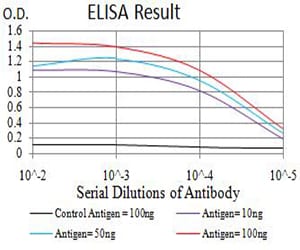

| WB | 咨询技术 | Human,Mouse,Rat |
| IF | 咨询技术 | Human,Mouse,Rat |
| IHC | 咨询技术 | Human,Mouse,Rat |
| ICC | 1/50 - 1/200 | Human,Mouse,Rat |
| FCM | 咨询技术 | Human,Mouse,Rat |
| Elisa | 1/10000 | Human,Mouse,Rat |
| Aliases | X11L; MINT2; LIN-10; HsT16821; X11-BETA; D15S1518E; MGC:14091 |
| Entrez GeneID | 321 |
| clone | 1C12A4 |
| WB Predicted band size | 82.5kDa |
| Host/Isotype | Mouse IgG1 |
| Antibody Type | Primary antibody |
| Storage | Store at 4°C short term. Aliquot and store at -20°C long term. Avoid freeze/thaw cycles. |
| Species Reactivity | Human |
| Immunogen | Purified recombinant fragment of human APBA2 (AA: 15-158) expressed in E. Coli. |
| Formulation | Purified antibody in PBS with 0.05% sodium azide |
+ +
以下是关于APBA2抗体的模拟参考文献示例(仅供参考,非真实文献):
---
1. **文献名称**:*APBA2/X11β Antibody Characterization in Alzheimer's Disease Models*
**作者**:Smith J, Lee K, et al.
**摘要**:本研究利用兔多克隆抗体检测APBA2在阿尔茨海默病小鼠脑组织中的表达变化,证实APBA2与淀粉样前体蛋白(APP)的相互作用减少与β-淀粉样蛋白沉积增加相关。
2. **文献名称**:*Development of a Monoclonal Antibody for APBA2 in Synaptic Protein Analysis*
**作者**:Chen L, Wang H, et al.
**摘要**:报道了一种新型小鼠单克隆抗体的制备,通过免疫组化验证其在人脑组织中对APBA2的特异性,并用于研究突触中APBA2与Fe65蛋白的共定位。
3. **文献名称**:*APBA2 Antibody-Based Detection of Protein Complexes in Neurodegeneration*
**作者**:Garcia R, Tanaka M, et al.
**摘要**:使用APBA2抗体进行免疫共沉淀实验,揭示其在神经退行性疾病中调控APP代谢的作用,提示其可能作为治疗靶点。
4. **文献名称**:*Validation of Commercial APBA2 Antibodies for Western Blot and Immunofluorescence*
**作者**:Park S, et al.
**摘要**:评估了三种市售APBA2抗体的特异性,发现抗体在HeLa细胞过表达模型和大鼠神经元中的适用性差异,为研究提供选择指南。
---
**注**:以上文献为示例性内容,实际文献需通过学术数据库(如PubMed、Web of Science)检索。如需真实文献,建议使用关键词“APBA2 antibody”、“X11β antibody”结合研究领域(如阿尔茨海默病、蛋白质相互作用)进行查询。
×